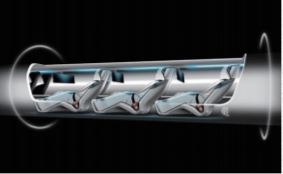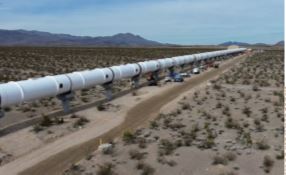The summer vacation month of August and Chuseok in September are periods that many Kingos are looking forward to. It is, however, not always that easy to get to a chosen destination because of traffic congestion on the roads. What if it took only 20 minutes from Seoul to Busan without any delays? It would be expected to be a pleasant and comfortable journey. Accordingly, the Sungkyun Times (SKT) would like to describe the concept and the operation principles of a hyperloop, the obstacles of it, and the directions of development.
What Is a Hyperloop?
Concept of a Hyperloop
A hyperloop is a vacuum tube transportation system that was first suggested by Elon Musk, the head of Tesla, and Space X. The basic idea came from the pneumatic tube which was used in hospitals and post offices in the early 20th century. The pneumatic tube can carry things like letters by using the air power created by air pressure. The hyperloop is almost the same as the pneumatic tube, but a magnetic levitation capsule moves in the vacuum tube. It can run at a speed of 1,280km/h and could potentially travel from Seoul to Busan within 16 minutes. The concept of the hyperloop is opensource due to the purpose of development suggested by Elon Musk, so anyone who wants it can develop it.
Operation Principles of a Hyperloop
The two most significant obstacles of high-speed rail are the friction and air resistance occurred during high-speed movement. A hyperloop can theoretically overcome these problems with magnetic levitation capsules and low-pressure tubes close to the vacuum status. Magnetic levitation makes the capsule levitate and removes the friction between the capsule and the tube. Then, the vacuum tube eliminates the air resistance. Two types of forces, thrust power and levitation force are required to move hyperloop capsules. A hyperloop capsule consists of three main parts, a thrust core for the thrust, a Halbach magnet array for the magnetic levitation, and a power conditioning unit for electricity supply. When the capsule first moves, it uses a linear motor of the thrust core located on the side of the capsule to gain acceleration by itself. When this acceleration reaches approximately 32km/ h, an induced current flows between the permanent magnet of the Halbach array and the aluminum vacuum tube, which levitates the capsule in the air. The friction will be eliminated after the capsule is automatically levitated by its speed and induced current, and the speed will gradually increase to the velocity of sound because there is little friction. A hyperloop is an efficient method because it can levitate the capsule just by having a constant propulsion speed without a continuous power supply.

Obstacles in the Commercialization of Hyperloops
Technical Problems
1. Heat Radiation
The capsule of a hyperloop runs in partial vacuum tubes which have one-thousandth of the atmospheric pressure, and its air resistance seems negligible. If the capsule moves at 1,200km/h, however, the heat, due to the friction between the capsule and the air, is expected to gradually increase over time, which can cause damage to the capsule and its devices. Moreover, the capsule holds the heat instead of radiating it, because the partial vacuum tube diminishes the medium of heat which is the air.
2. Flow Control
Many capsules must be on the one same track to be considered as public transportation, just like a subway. Building one long vacuum tube and being able to maintain its stable vacuum status is technically impossible and would be inefficient. For instance, even if the long-distance vacuum tube is built, one capsule must be slowed down and the vacuum status reduced before it stops at the destination. In this process, the other capsule behind it will be affected and decelerate because they are in the same tube. It means that a hyperloop cannot be a perfect substitution for subways.
Safety Problems
If the tube is bent or the attached devices fall inside the tube, it can cause a serious accident because of the high-speed movement of the capsule. Assuming that the weight of the capsule is 3.1 tons, and the weight of 28 passengers is 80 kg for each, the kinetic energy would be 3.1 billion joules at 1,200km/h speed. This amount of energy is equal to a 75kg TNT explosion. These potential accidents have caused concern about the hyperloop due to the fact it would probably have to go through residential areas and highways as public transportation. Moreover, the capsule is contained in the tube and moves inside of it, and it must reach the destination unconditionally even if there is any problem with the passenger’s safety.

Development Status of Hyperloops and Directions of Development
Development Status
Nevertheless, hyperloops are now rapidly developing, and many countries are participating in the development. On May 11th, 2016, “Hyperloop One” of the United States succeeded in testing on a 800m track at 187km/h for 111 seconds. This remarkable achievement shows the technical feasibility of supersonic magnetic levitation transportation. Accordingly, Hyperloop One has suggested the goal of moving people by hyperloop by 2021. Another company, Hyperloop Technology Transportation (HTT), first revealed the appearance of a full-scale passenger capsule, Quintero One, in October 2018. In South Korea, Ulsan National Institute of Science and Technology (UNIST) created a 1/40 size of an actual capsule model and succeeded in testing it, although it only moved at 10km/h. It is a miniature model that is 1.1 meters long and 27 centimeters across, but it is a meaningful experiment because it contains all the core technologies of a hyperloop.

Development of New Materials and Empirical Experiments
To make the hyperloop safe and stable, the development of new material to use in the capsule is necessary. Capsules must be shock-resistant and endure the heat during movement. Also, deceleration and acceleration must be performed more flexibly in the vacuum tube. Accordingly, HTT developed a new material that is ten times stronger than steel and weighs only one-fifth of aluminum, which is called Vibranium. Theoretically, all devices and parts for the hyperloop track structures, such as vacuum pumps, linearity maintenance have already been developed. The comprehensive activation experiment on a real track, however, has not been conducted yet, so the empirical experiments close to the commercialization level must be carried out gradually.
The dream of high-speed transportation is a far off target for humanity. It is still uncertain that the hyperloop can substitute high-speed railways and highways. If it is commercialized, however, it can solve most of the current traffic congestion problems. South Korea is also one of the pioneers of the development of hyperloop technology. If research is carried out steadily with government support, it will not be a distant dream to go to Busan at supersonic speed
